![]()
![]()
![]()
Use LEFT and RIGHT arrow keys to navigate between flashcards;
Use UP and DOWN arrow keys to flip the card;
H to show hint;
A reads text to speech;
124 Cards in this Set
- Front
- Back
|
What is the Uveal tract? |
Uveal tract is the heavily pigmented vascular coat between the sclera and the retina. It is made up of the iris, choroid and ciliary body |
|
|
What is the Iris? |
Most anterior of the uveal structures, providing nutrition of the anterior segment by diffusion through aqueous. Sphincter and dilator muscles control light into the eye |
|
|
What is the Ciliary body |
Inner layer of uveal tract which secretes aqueous. Can contract which varies tension on lens zonules resulting accommodation |
|
|
What is the Choroid? |
Expandable vascular layer supplying nutrition to rods and cones (i.e., outer retina)
|
|
|
Name the signs and symptoms associated with uveitis. |
• Pain • Photophobia • Blurred vision • Lacrimation • Conjunctival and perilimbal injection • Flare • Cells • Keratic Precipitates (KP) • Iris Nodules • Small pupils |
|
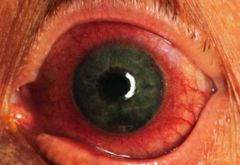
Is this uveitis? Explain why. |
Yes Red sore conjunctiva all the way to the limbus, no white gap. |
|

Is this uveitis? Explain why |
No Most likely a burst blood vessel. The conjunctiva is a thin loose membrane so blood spreads very easily making it look worse than it is. |
|
|
Describe the pain associated with uveitis. |
• Mild discomfort to severe pain. • Irritation of ciliary nerves, ciliary muscle spasm |
|
|
Describe the Photophobia associated with uveitis. |
• Mild to severe (blepharospasm) • Ciliary spasm resulting in trigeminal irritation |
|
|
Describe the Blurred vision associated with uveitis. |
Cloudy media (although vision can be good even in the presence of dense flare and cells), can also result from macula oedema |
|
|
Explain the lacrimation associated with uveitis. |
Associated with photophobia |
|
|
What is Conjunctival and perilimbal injection? |
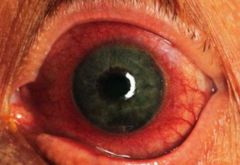
Pink to violet circumlimbal flush.
Also, known as ciliary injection, or “ciliary flush”
Indicated by a ring of dilated episcleral vessels radiating from the limbus |
|
|
What is flare? |
Flare milkiness of aqueous humour (protein from uveal vessels) |
|
|
Describe the cells associated with uveitis. |
Cells inflammatory and pigmented cells in anterior chamber (white blood cells from uveal vessels) |
|
|
What are Keratic Precipitates (KP)? |
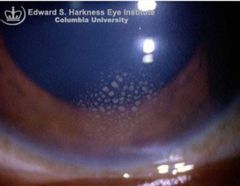
Deposits (clusters) of inflammatory cells on endothelium |
|
|
What are Iris nodules? |
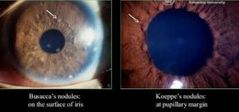
Fluffy white precipitates on inner surface of pupil margin (Koeppe) or on iris surface (Busacca) |
|
|
What is a Haemorrhage? |
Blood in anterior chamber (rare) |
|
|
What is Hypopyon? |
Purulent exudate in lower anterior chamber |
|
|
Describe the IOP variation associated with uveitis. |
low IOP is characteristic but glaucoma may develop as secondary complication |
|
|
What is Iris atrophy? |
Diffuse or focal atrophy of iris pigment epithelium |
|
|
What is Synechiae? |
Adhesions of iris to lens in pupil zone or of iris to angle structures |
|
|
What are Lens precipitates? |
Inflammatory cells deposited on anterior lens capsule |
|
|
What are the classification systems for uveitis? |
• anatomical • clinical • aetiological • Pathological |
|
|
Name the anatomical types of uveitis. |
• Anterior uveitis • Intermediate uveitis • Posterior uveitis • Pan-uveitis • Endophthalmitis |
|
|
What is anterior uveitis? |
• iritis • iridocyclitis |
|
|
What is iritis? |
inflammation of iris |
|
|
What is iridocyclitis? |
inflammation affecting iris and ciliary body |
|
|
What is intermediate uveitis? |
• inflammation of ciliary body and anterior portion of choroid • secondary involvement of peripheral retina |
|
|
What is Posterior uveitis? |
• Choroiditis • Chorioretinitis |
|
|
What is Choroiditis? |
inflammation of choroid |
|
|
What is Chorioretinitis? |
secondary inflammation of retina |
|
|
What is Pan-uveitis? |
Combination of anterior, intermediate and posterior uveitis |
|
|
What is Endophthalmitis? |
Inflammation of all intraocular structures |
|
|
What is the clinical classification of uveitis? |
Based on the presence of symptoms at onset, and duration of episodes of uveitis: • Acute • Chronic |
|
|
What would qualify as acute uveitis? |
• sudden symptomatic onset • persists for 6 weeks or less |
|
|
What would qualify as chronic uveitis? |
• onset may be asymptomatic • persists for months or years |
|
|
What is the aetiological classification of uveitis? |
Based on the origin of the cause of uveitis: • Exogenous uveitis • Endogenous uveitis |
|
|
What is Exogenous uveitis? |
Due to external influences external injury invasion of micro-organisms from outside the body |
|
|
What is Endogenous uveitis? |
Due to internal influences: associated with systemic disease infection by bacteria, fungi, viruses, protozoans or roundworms |
|
|
What is the Pathological classification of uveitis? |
Based on the pathological description of the inflammatory response: • granulomatous uveitis |
|
|
What is granulomatous uveitis? |
inflammatory response associated with the formation of rounded growths of connective tissue and blood vessels (granuloma) in the affected area non-granulomatous uveitis |
|
|
What percentage of uveitis cases appear in over 20 year olds |
90% |
|
|
What is the mean onset age for uveitis? |
40 years |
|
|
What is the most common form of uveitis? |
Anterior uveitis |
|
|
What are some of the systemic diseases/ reasons they are associated with uveitis? |
• Arthritis • Crohn’s disease Inflammatory bowel disease • Family history • Past ocular history – any uveitis |
|
|
What would be seen under slit lamp biomicroscopy of the anterior eye with uveitis? |
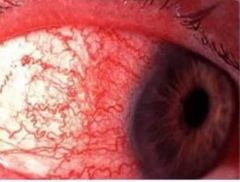
presence of circum-limbal injection (ciliary flush) |
|
|
What would be seen under slit lamp biomicroscopy of the cornea with uveitis? |
presence of keratic precipitates |
|
|
What type of keratic precipitates would be seen with acute uveitis? |
fine, white KPs = acute, non-granulomatous anterior uveitis |
|
|
What type of keratic precipitates would be seen with chronic uveitis? |
large, yellow KPs = chronic, granulomatous anterior uveitis |
|
|
What would be seen under slit lamp biomicroscopy of the anterior chamber with uveitis? |
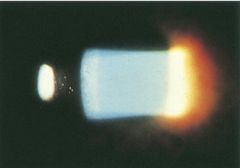
Flare and cell Hypopyon |
|
|
Grading scale for flare and cells |
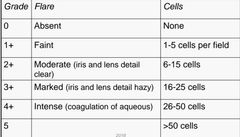
|
|
|
What would be seen under slit lamp biomicroscopy of the Iris with uveitis? |
• Iris presence of synechiae - anterior synechiae - posterior synechiae • Iris presence of nodules - Koeppe - Busacca |
|
|
What is anterior synechiae? |
Adhesions between inflamed iris tissue and posterior corneal surface |
|
|
What is posterior synechiae? |
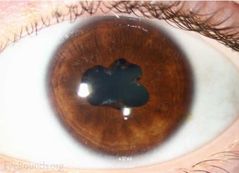
Adhesions between inflamed iris tissue and anterior surface of crystalline lens |
|
|
What is Koeppe nodules? |
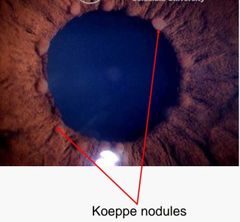
Koeppe nodules at pupil margin |
|
|
What are Busacca nodules? |

Busacca nodules within iris stroma |
|
|
What would be seen under slit lamp biomicroscopy of the anterior Crystalline lens with uveitis? |
Pigment and fibrin deposits |
|
|
What would be seen under slit lamp biomicroscopy of the posterior crystalline lens with uveitis? |
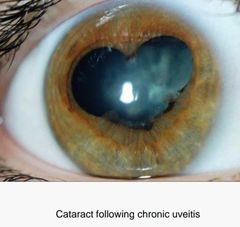
posterior subcapsular cataract • due to uveitis • secondary to steroid therapy |
|
|
What would be seen under slit lamp biomicroscopy of the vitreous with uveitis? |
suspect posterior uveitis if cells are detected in anterior vitreous |
|
|
What would be seen under slit lamp biomicroscopy of the retina with uveitis? |
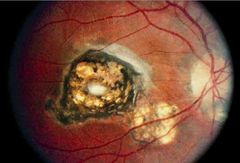
active or inactive inflammatory response at posterior pole or peripheral retina |
|
|
What systemic conditions increase the likelihood of uveitis? |
• Inflammatory conditions - arthritis, ankylosing spondylitis • Compromised immune system - For example AIDS • Parasitic infestations/infections • Bacterial, viral or fungal infections |
|
|
What types of arthritis is associated with uveitis? |
• Ankylosing spondylitis • Reiter’s syndrome • Psoriatic arthritis • Juvenile chronic arthritis |
|
|
What is Ankylosing spondylitis? |
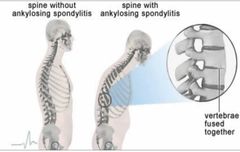
• Ankylosing – bones fuse together across a joint • Spondylitis – inflammation of the spine |
|
|
Who is Ankylosing spondylitis more common in? |
More common in men than women (5:1 ratio)prevalence approx 1 in 1000 |
|
|
What does Ankylosing spondylitis increase the chance of? |
• Increases risk of other inflammatory conditions: -ulcerative colitis (Crohn’s disease)-skin inflammation (psoriasis) |
|
|
What is the onset of Ankylosing spondylitis |
40 years old |
|
|
When is the pain worse with Ankylosing spondylitis? |
• Morning • provoked by periods of inactivity |
|
|
What are the ocular effects of Ankylosing spondylitis? |
Acute iritis • recurrent • usually unilateral • chronic iritis can occur
Visual prognosis is good |
|
|
Name some non-infectious systemic diseases that uveitis can present in. |
• Sarcoidosis • Behcet’s disease • Vogt-Koyanagi-Harada (V-K-H) syndrome • Harada’s disease |
|
|
What is sarcoidosis? |
• Non-caseating (don’t break down) granolomata can be found in any organ. • Lungs commonly affected (90% of cases) |
|
|
Who is sarcoidosis more common in? |
Black people |
|
|
When does sarcoidosis present? |
• Acute onset 3rd decade of life • Insidious onset 5th decade of life |
|
|
What percentage of sarcoidosis cases present with ocular involvement? |
30% |
|
|
Name some of the ocular effects of sarcoidosis. |
• Eyelid lesions – granulomata at eyelid margin • Anterior segment – scleral nodule, follicular conjunvititis • Anterior uveitis – acute or chronic iridocyclitis • Vitreous involvement – diffuse vitritis, snowball opacities • Retinal involvement – periphlebitis, retinal granulomata, choroidal granulomata, optic nerve lesions (granuloma, papilloedema, neovascularisation) |
|
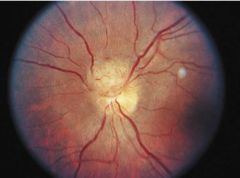
What is this? |
Optic nerve granuloma in Sarcoidosis |
|
|
How do you treat sarcoidosis? |
Systemic steroids to control posterior segment inflammation |
|
|
What is Behcet's disease? |
rare disorder that causes blood vessel inflammation throughout your body. They can include mouth sores, eye inflammation, skin rashes and lesions |
|
|
How does Behcets disease present? |

oral and genital ulceration, skin lesions |
|
|
What are the ocular features if Behcets disease? |
• Acute recurrent iridocyclitis • Retinitis inflammation of retinal tissues • Vitritis |
|
|
What is the treatment for behcet's disease? |
• High dose systemic steroids to reduce inflammation Immuno suppressant drugs. • Plasma exchange (plasmapheresis) -reduces concentration of inflammatory mediators in blood |
|
|
Name some chronic systemic infections that uveitis can present in. |
• Acquired syphilis • Tuberculosis • Leprosy • Lyme disease |
|
|
What is Lyme disease? |
A serious illness transmitted to humans by infected blacklegged ticks, leads to a variety of symptoms for patients. |
|
|
What are some of common symptoms presented with Lyme disease? |
• fatigue • headache • fever • characteristic erythema • migraines • rash |
|
|
At the final stage of Lyme disease what ocular symptoms may present? |
• pars planitis • branch artery occlusion • retinal vasculitis • optic neuritis • uveitis • keratitis |
|
|
What is Tuberculosis (TB)? |
• TB – a chronic granulomatous infection
• Nodular lesions (tubercles) formed in lungs -Spreads into lymphatic system |
|
|
What is the ocular involvement in TB? |
• External eye – lesions of eyelids, conjunctiva, cornea and sclera • Uvetits (occasionally) -Chronic iridocyclitis -Choroiditis • Retinal vasculitis |
|
|
What are the parasitic infections that uveitis may present in? |
• Toxoplasmosis • Toxocariasis |
|
|
What is Toxoplasmosis? |
Organism: Toxoplasma gondii protozoan |
|
|
What is Toxoplasmosis carried by? |
• Cats (definite host) • cattle, mice, humans |
|
|
How does Toxoplasmosis occur in humans? |
• Eating undercooked meat from an intermediate host. • Accidental ingestion of sporocysts (e.g. from cat litter or soil). • Transplacental infection during pregnancy when mother has acute toxoplasmosis |
|

What is this? |
Active toxoplasmosis |
|
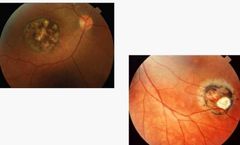
What is this? |
Inactive toxoplasmosis |
|
|
What is Toxocariasis |
Organism: Toxocara canis • Intestinal roundworm (ascarid) |
|
|
What carries Toxocariasis? |
Carried by dogs (the definitive host) |
|
|
What are the 2 forms of human infestation of Toxocariasis? |
• Visceral larva migrans • Ocular toxocariasis |
|
|
What is Visceral larva migrans of Toxocariasis? |
• Severe systemic infestation First presentation at about 2 years of age |
|
|
What is ocular Toxocariasis? |
Only eyes are affected Px otherwise healthy |
|
|
What the common form of ocular Toxocariasis? |
• Chronic endophthalmitis • Granuloma at posterior pole • Granuloma in retinal periphery |
|
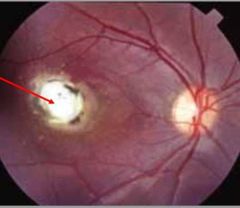
What is this? |
Ocular Toxocariasis Granulomar at posterior pole |
|
|
What is the effect on visual function with Toxoplasmosis and Toxocaniasis? |
• Depends on site of lesion.
• VA reduced significantly if fovea is involved.
• Peripheral lesions produce a visual field defect. |
|
|
What are the secondary effects that may also disrupt visual function with Toxoplasmosis and Toxocaniasis? |
• Cystoid macular oedema • Tractional retinal detachment |
|
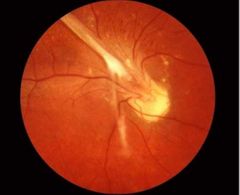
What is this? |
Ocular toxocariasis tractional |
|
|
What is the treatment for Toxoplasmosis? |
• Systemic steroids
• Cryotherapy -Peripheral retinal lesions |
|
|
What is the treatment for Toxocariasis? |
• Systemic or periocular steroids • Pars plana vitrectomy for severe inflammatory reactions |
|
|
What are some of the causes of viral uveitis? |
• Herpes zoster iritis • Herpes simplex iritis • Acute retinal necrosis • Cytomegalovirus • Congenital rubella |
|
|
What % of herpes zoster ophthalmicus cases develop iritis? |
40% |
|
|
What are the complications of Herpes zoster Iritis? |
• Iris atrophy in 20% of chronic cases
• Secondary glaucoma due to trabecular meshwork blockage (10% of cases)
• Secondary cataract |
|
|
What can cause fungal uveitis? |
Candidiasis |
|
|
Who/What type of people does candidiasis affect? |
• Drug-addicts (use of infected needles) • Immuno-compromised patients (HIV) • Haemodialysis patients (kidney dysfunction) |
|
|
What are the ocular features of candidiasis? |
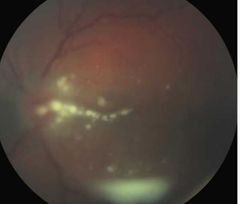
• Anterior uveitis with hypopyon • Posterior uveitis with multifocal retinitis, and ‘strings of pearls’ in the vitreous |
|
|
What is the treatment for candidiasis? |
• Administration of 5-fluorocytosine and ketoconazole • Pars plana vitrectomy when candidiasis leads to endophthalmitis |
|
|
Name some Common idiopathic specific uveitis syndromes. |
• Fuch’s uveitis syndrome • Intermediate uveitis • Juvenile chronic iridocyclitis • Acute anterior uveitis in young adults |
|
|
What is Fuch’s uveitis syndrome? |
• Anterior uveitis; non-granulomatous; frequently unilateral
• Chronic condition (can last for years) |
|
|
Who can Fuch’s uveitis syndrome affect? |
Affects middle-aged adults but can also occur in childhood |
|
|
What are the clinical features of Fuch’s uveitis syndrome? |
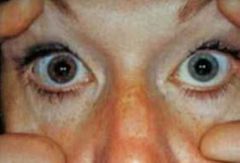
• Keratic precipitates: small; grey-white; round or stellate • Grade 2 anterior chamber flare/cells • Diffuse iris atrophy iris nodules occasionally seen • Hypochromia of affected eye • Posterior synechiae DO NOT form |
|
|
What are the complications of Uveitis? |
• Secondary glaucoma blockage of anterior chamber angle by inflammatory cells IOP elevation
• Cataract direct onset due to inflammationand/or secondary to long-term steroid therapy
• Endophthamitis intense inflammation of whole eye. Extremely serious |
|
|
What are the aims in managing uveitis? |
• Preservation of vision • Pain relief • Eliminate inflammation • Prevent synechiae • Manage IOP |
|
|
What is the optometric role in managing uveitis ? |
Referral to A&E |
|
|
What are the therapeutic options for treating uveitis? |
• Steroids • Cycloplegics • Non-steroidal anti-inflammatory drugs (NSAIDS) • Immunosuppression |
|
|
What do steroids do? |
• Decrease inflammation • Reduce exudate production • Stabilize cell membranes • Inhibit lysozyme release from granulocytes • Suppress circulation of lymphocytes |
|
|
Name some common steroids for uveitis. |
• prednisolone • fluorometholone • betamethasone • dexamethosone • hydrocortisone |
|
|
What are the complications from the use of steroids? |
• IOP elevation • Cataract -posterior subcapsular • Tissue oedema (systemic use) |
|
|
Why are Cycloplegics given in the treatment of uveitis? |
• Breaks down posterior synechiae • reduces pain Cyclopentolate HCl (1%); 1 drop 3-4 times per day |
|
|
Why would immunosuppressents be used for the treatment of uveitis? |
Used in severe uveitis following failure of other treatment strategies |

